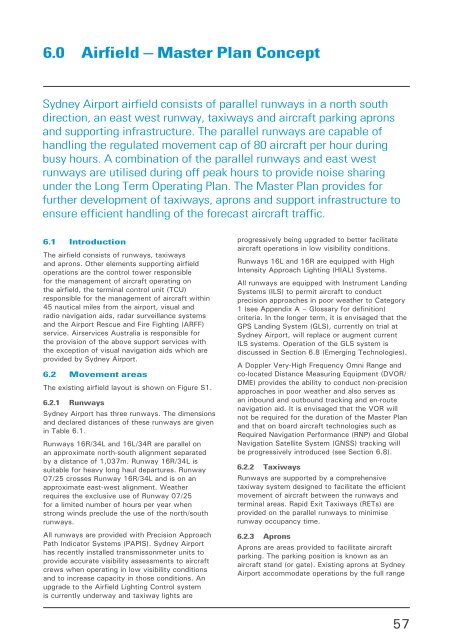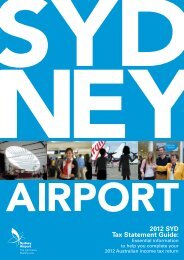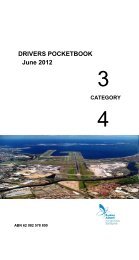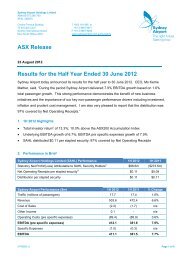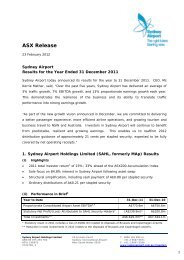Master Plan 2009 - Sydney Airport
Master Plan 2009 - Sydney Airport
Master Plan 2009 - Sydney Airport
Create successful ePaper yourself
Turn your PDF publications into a flip-book with our unique Google optimized e-Paper software.
6.0 Airfield – <strong>Master</strong> <strong>Plan</strong> Concept<br />
<strong>Sydney</strong> <strong>Airport</strong> airfield consists of parallel runways in a north south<br />
direction, an east west runway, taxiways and aircraft parking aprons<br />
and supporting infrastructure. The parallel runways are capable of<br />
handling the regulated movement cap of 80 aircraft per hour during<br />
busy hours. A combination of the parallel runways and east west<br />
runways are utilised during off peak hours to provide noise sharing<br />
under the Long Term Operating <strong>Plan</strong>. The <strong>Master</strong> <strong>Plan</strong> provides for<br />
further development of taxiways, aprons and support infrastructure to<br />
ensure efficient handling of the forecast aircraft traffic.<br />
6.1 Introduction<br />
The airfield consists of runways, taxiways<br />
and aprons. Other elements supporting airfield<br />
operations are the control tower responsible<br />
for the management of aircraft operating on<br />
the airfield, the terminal control unit (TCU)<br />
responsible for the management of aircraft within<br />
45 nautical miles from the airport, visual and<br />
radio navigation aids, radar surveillance systems<br />
and the <strong>Airport</strong> Rescue and Fire Fighting (ARFF)<br />
service. Airservices Australia is responsible for<br />
the provision of the above support services with<br />
the exception of visual navigation aids which are<br />
provided by <strong>Sydney</strong> <strong>Airport</strong>.<br />
6.2 Movement areas<br />
The existing airfield layout is shown on Figure S1.<br />
6.2.1 Runways<br />
<strong>Sydney</strong> <strong>Airport</strong> has three runways. The dimensions<br />
and declared distances of these runways are given<br />
in Table 6.1.<br />
Runways 16R/34L and 16L/34R are parallel on<br />
an approximate north-south alignment separated<br />
by a distance of 1,037m. Runway 16R/34L is<br />
suitable for heavy long haul departures. Runway<br />
07/25 crosses Runway 16R/34L and is on an<br />
approximate east-west alignment. Weather<br />
requires the exclusive use of Runway 07/25<br />
for a limited number of hours per year when<br />
strong winds preclude the use of the north/south<br />
runways.<br />
All runways are provided with Precision Approach<br />
Path Indicator Systems (PAPIS). <strong>Sydney</strong> <strong>Airport</strong><br />
has recently installed transmissonmeter units to<br />
provide accurate visibility assessments to aircraft<br />
crews when operating in low visibility conditions<br />
and to increase capacity in those conditions. An<br />
upgrade to the Airfield Lighting Control system<br />
is currently underway and taxiway lights are<br />
progressively being upgraded to better facilitate<br />
aircraft operations in low visibility conditions.<br />
Runways 16L and 16R are equipped with High<br />
Intensity Approach Lighting (HIAL) Systems.<br />
All runways are equipped with Instrument Landing<br />
Systems (ILS) to permit aircraft to conduct<br />
precision approaches in poor weather to Category<br />
1 (see Appendix A – Glossary for definition)<br />
criteria. In the longer term, it is envisaged that the<br />
GPS Landing System (GLS), currently on trial at<br />
<strong>Sydney</strong> <strong>Airport</strong>, will replace or augment current<br />
ILS systems. Operation of the GLS system is<br />
discussed in Section 6.8 (Emerging Technologies).<br />
A Doppler Very-High Frequency Omni Range and<br />
co-located Distance Measuring Equipment (DVOR/<br />
DME) provides the ability to conduct non-precision<br />
approaches in poor weather and also serves as<br />
an inbound and outbound tracking and en-route<br />
navigation aid. It is envisaged that the VOR will<br />
not be required for the duration of the <strong>Master</strong> <strong>Plan</strong><br />
and that on board aircraft technologies such as<br />
Required Navigation Performance (RNP) and Global<br />
Navigation Satellite System (GNSS) tracking will<br />
be progressively introduced (see Section 6.8).<br />
6.2.2 Taxiways<br />
Runways are supported by a comprehensive<br />
taxiway system designed to facilitate the efficient<br />
movement of aircraft between the runways and<br />
terminal areas. Rapid Exit Taxiways (RETs) are<br />
provided on the parallel runways to minimise<br />
runway occupancy time.<br />
6.2.3 Aprons<br />
Aprons are areas provided to facilitate aircraft<br />
parking. The parking position is known as an<br />
aircraft stand (or gate). Existing aprons at <strong>Sydney</strong><br />
<strong>Airport</strong> accommodate operations by the full range<br />
57


